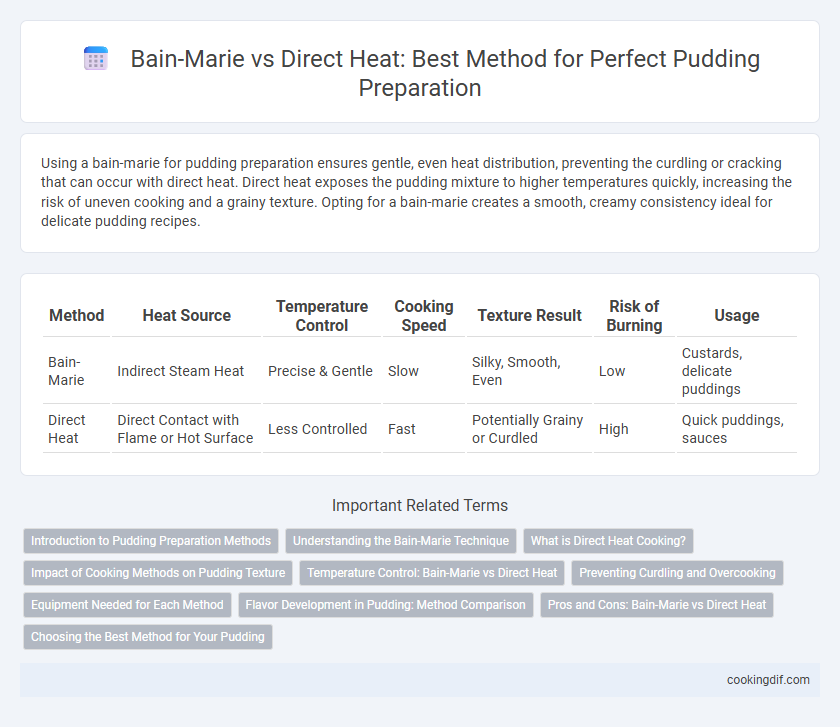Using a bain-marie for pudding preparation ensures gentle, even heat distribution, preventing the curdling or cracking that can occur with direct heat. Direct heat exposes the pudding mixture to higher temperatures quickly, increasing the risk of uneven cooking and a grainy texture. Opting for a bain-marie creates a smooth, creamy consistency ideal for delicate pudding recipes.
Table of Comparison
| Method | Heat Source | Temperature Control | Cooking Speed | Texture Result | Risk of Burning | Usage |
|---|---|---|---|---|---|---|
| Bain-Marie | Indirect Steam Heat | Precise & Gentle | Slow | Silky, Smooth, Even | Low | Custards, delicate puddings |
| Direct Heat | Direct Contact with Flame or Hot Surface | Less Controlled | Fast | Potentially Grainy or Curdled | High | Quick puddings, sauces |
Introduction to Pudding Preparation Methods
Pudding preparation techniques significantly impact texture and flavor, with bain-marie and direct heat being the primary methods. Bain-marie utilizes gentle, indirect steam heat to cook pudding evenly, preventing curdling and ensuring a smooth, creamy consistency. Direct heat applies intense, direct contact with the heat source, which can speed up cooking but risks uneven texture and potential scorching.
Understanding the Bain-Marie Technique
The bain-marie technique gently cooks pudding by placing the mixture in a container set within a hot water bath, ensuring even heat distribution and preventing curdling or burning. This method maintains a consistent, moderate temperature ideal for delicate desserts like custard-based puddings. Direct heat risks overheating and uneven cooking, often resulting in a grainy texture or burnt edges, making bain-marie the preferred approach for smooth, creamy pudding.
What is Direct Heat Cooking?
Direct heat cooking involves applying heat straight to the pudding mixture, typically using a stovetop or oven, which can result in faster cooking but increases the risk of uneven heat distribution and scorching. This method requires constant stirring to prevent the pudding from burning or curdling due to the intense, focused heat. Ideal for thicker puddings, direct heat can create a more robust texture but demands close attention to avoid overcooking.
Impact of Cooking Methods on Pudding Texture
Using a bain-marie for pudding preparation regulates heat gently, resulting in a smooth, creamy texture by preventing curdling and overcooking. Direct heat exposes the pudding to higher temperatures, often causing a grainy or rubbery consistency due to rapid protein coagulation. The controlled, even heat distribution of a bain-marie is essential for achieving the ideal custard-like softness in puddings.
Temperature Control: Bain-Marie vs Direct Heat
Using a bain-marie for pudding preparation ensures gentle, consistent temperature control by surrounding the custard with hot water, preventing curdling and uneven cooking. Direct heat exposes the pudding mixture to higher, fluctuating temperatures, increasing the risk of overheating and texture irregularities. Precision in temperature maintenance is crucial for smooth, creamy pudding results, making bain-marie the preferred method for delicate custards.
Preventing Curdling and Overcooking
Using a bain-marie for pudding preparation ensures gentle, even heat distribution, significantly reducing the risk of curdling and overcooking by maintaining a consistent temperature below boiling point. Direct heat risks uneven cooking and hot spots, causing proteins in the pudding mixture to coagulate too quickly, leading to undesirable texture and separation. Controlled bain-marie heating preserves a smooth, creamy pudding by preventing temperature spikes that compromise custard stability.
Equipment Needed for Each Method
Preparing pudding using a bain-marie requires a heatproof container and a larger pan to hold hot water, ensuring gentle, even cooking without direct heat. In contrast, the direct heat method demands a heavy-bottomed saucepan to prevent scorching and constant stirring to achieve smooth consistency. Equipment choice significantly impacts texture and cooking precision during pudding preparation.
Flavor Development in Pudding: Method Comparison
Using a bain-marie for pudding preparation ensures gentle, even heat distribution, promoting gradual flavor development and preventing scorching or curdling. Direct heat methods can accelerate cooking but risk uneven temperature spikes that may impair texture and reduce the richness of complex flavors. The controlled environment of a bain-marie preserves delicate ingredients, enhancing the pudding's smoothness and depth of taste.
Pros and Cons: Bain-Marie vs Direct Heat
Using a bain-marie for pudding preparation ensures gentle and even heat distribution, minimizing the risk of curdling and resulting in a smoother, creamier texture. Direct heat heats faster but can lead to uneven cooking and potential burning or curdling if not carefully monitored. Bain-marie requires more time and equipment, while direct heat offers speed and simplicity, making each method suitable depending on the desired pudding consistency and preparation time.
Choosing the Best Method for Your Pudding
Using a bain-marie for pudding preparation ensures gentle, even heat distribution, preventing curdling and promoting a silky texture that direct heat often fails to achieve. Direct heat can cook puddings faster but risks overheating and uneven consistency, making it suitable only for sturdier recipes that tolerate higher temperatures. Opting for a bain-marie is ideal for delicate, custard-based puddings, guaranteeing smoothness and optimal flavor retention.
bain-marie vs direct heat for pudding preparation Infographic

 cookingdif.com
cookingdif.com